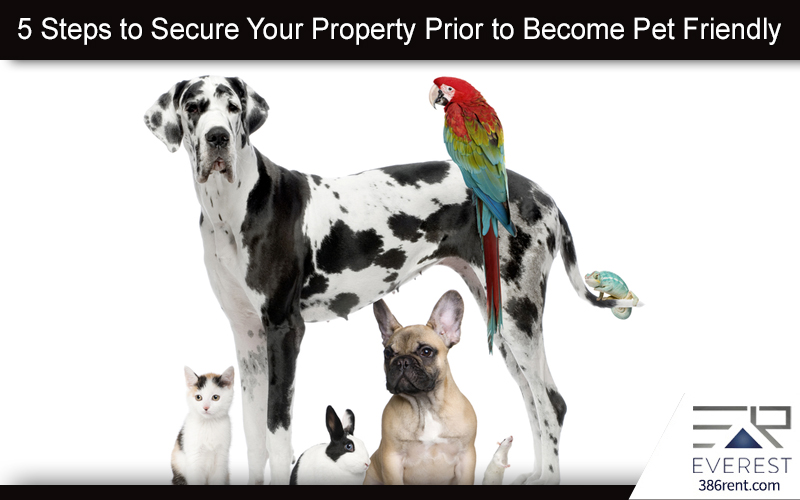The owners of pets may be responsible for causing property damage as well as bodily injury to your pets. In any case, you are looking for the most desirable tenants regardless of whether they have companion animals.
Historically, landlords with a pet-friendly policy have found equilibrium by limiting the number of specific breeds with higher risks, such as Pitbulls and Doberman Pinschers, or imposing weight restrictions.
However, the backlash from breed advocates is having an immediate impact: New York governor Kathy Hochul recently signed legislation prohibiting insurance companies from denying or delaying coverage. Is it your intention to join the more risky ranks of pet-friendly landlords? If so, what measures should you take to protect your home?
Does your pet need to be more comfortable?
Choosing to allow pets -- giant dogs in particular -- is challenging for landlords. On the side, one, you risk damage to your property in addition to the possibility of noise disturbances, persistent odors, and obviously, the risk for injuries.
There are many positive reasons to leap: you'll attract a more significant number of applicants, as particular renters require housing in which their pets are permitted, and you could be able to charge more cost of rent or even add pet rent to your monthly bill.
It's still important to take certain precautions if you plan to allow pets.
If you want to permit pets to roam on your property, follow these steps first. An amount of planning can go a long way in the process of successfully managing an animal-friendly rental.
1. Make sure you know your insurance policy and local laws.
While the needle might be moving towards a more equitable policy regarding dog breeds, not every state and city has put protections similar to those found in New York.
The location of your home depending on your location, your homeowner's insurance company might still limit certain breeds of dogs in many U.S. cities that are still enforcing similar bans on all dogs in the community.
It is evident that if a specific breed of dog is prohibited in your area, your homeowner's insurance company (or your tenant's renters ' insurance company) will not cover the damages, and you don't want to keep them in your home./
However, these laws are being actively challenged and changed, So it's essential to keep in mind the news and the regulations in your locality could be changed.
2. Consider upgrading your flooring.
Even the most well-trained pet can sometimes have accidents and claws. Certain types of flooring, including vinyl and laminate, can more endure the demands of life with pets than shag carpet.
Even though upgrading your flooring is an expensive undertaking. However, it may be worthwhile in the long run, especially if you intend to take on pets. Soft flooring surfaces are more likely to hold staining or odors, resulting in expensive cleaning charges between tenants.
3. Landscape your yard and fence it.
Most pet owners want their dogs to go outside for their daily business, and, as an owner of the property, you probably have the same desire.
If you've put in beautiful flowers and lush foliage in your landscape, You might want to give your garden an extra look. You do not need Fido not to "water" your tomatoes or sunflowers.
Establishing an appropriate "potty" space is an excellent method to ensure that your pets have an area to do what they want to do without destroying the most fragile areas in your backyard living spaces.
You could consider covering the area with mulch or gravel that is durable and simple to clean when you need to. Fencing can divide the different areas and prevent pets from wandering off or escaping through a busy street.
4. Make sure you update your rental application and lease agreement.
If done correctly, allowing pets isn't so easy as selecting the "dogs permitted" box when you're creating your rental listings. It is essential to review the various forms to ensure that your rules are clear and have all the details you require from prospective tenants.
In the beginning, make sure to mention which kinds of pets you are allowing (including any weight or breed limitations) as well as the number of pets you will allow, and any additional pet rent or deposits that are required.
You might also wish to make renters purchase and submit proof of the renter's insurance policy which covers accidental injuries caused by dog bites.
When you fill out the rental application, it is also essential to find out information about animals that could soon be within your yard. Following questions might help you: Which breed is it? What's the size, type, and age that each dog is?
- How many years have you owned it?
- Are all animals up-to-date with licenses and vaccinations?
- Are all your pets neutered or spayed?
- Do all pets have house training?
- Have you ever seen your pet behave rudely towards you or anyone else?
- Are all pets following an active flea prevention program?
- Who takes care of your pet while you're away?
Additionally, your lease also needs to be amended by adding a pet-friendly addendum that specifically outlines the rights, responsibilities, and guidelines for pets in the rental and pet rents and deposits and whether or not they are refundable./
5. You can meet with the animal(s) personally during the screening process.
To calm your mind to feel at ease, you may need to meet the tenants' pets in person during the process of screening. In addition to providing you with (albeit short) insights into the animal's behavior, you'll gain valuable information on the tenants.
Are they carrying bags of waste to dispose of their pet? Do the dogs have leashes and are obeying commands? A 15-minute session can provide you with many details about the dog and the owner.
Bottom Line
Pet-friendly living does come with its risks. However, it provides a more significant number of applicants and higher rental income in the form of a pet and greater levels of affection. You should ensure that the necessary work is completed before the deadline to ensure your safety and the safety of your property.
If you’d like to talk more about property management, or you need help with Everest Property Management, please contact us at Everest Realty.




 As a top producing Realtor and Property Manager; Terry specializes in sales, extensive construction homes, rentals, REO’s, short sales, and all aspects of Real Estate. After graduating the University of Michigan with a master in MBA, Terry continued his endeavor and now has over 15+ years of experience in the Real Estate world. If there is anything that has to do with Real Estate and sales, you can always be sure of Terry to provide important, specialized knowledge.
As a top producing Realtor and Property Manager; Terry specializes in sales, extensive construction homes, rentals, REO’s, short sales, and all aspects of Real Estate. After graduating the University of Michigan with a master in MBA, Terry continued his endeavor and now has over 15+ years of experience in the Real Estate world. If there is anything that has to do with Real Estate and sales, you can always be sure of Terry to provide important, specialized knowledge.




